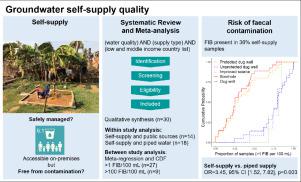Water Research ( IF 11.4 ) Pub Date : 2021-06-10 , DOI: 10.1016/j.watres.2021.117350 Franziska Genter 1 , Juliet Willetts 1 , Tim Foster 1

|
Self-supply is a ubiquitous response by households to the public water supply inadequacies found worldwide. Self-supply is invested in and managed by an individual household, accessible on-premises and unregulated. Vulnerability to faecal contamination is a concern due to reliance on low-cost technologies and shallow groundwater. This review aims to evaluate the evidence base on the safety of groundwater self-supply in low- and middle income countries in relation to faecal contamination. Differences in microbial water quality between source types, settings, countries and ownership were investigated. A search of peer-reviewed studies in low- and middle income countries was conducted in online databases, including PubMed, Web of Science, ProQuest and Environmental Complete. Studies were included if they had sufficient detail about the water samples to be related to groundwater self-supply, contained extractable data on faecal indicator bacteria (FIB) including thermotolerant coliform or Escherichia coli and were published in English between 1990 and April 2020. A total of 30 studies were included, resulting in 100 datasets and 26,981 water samples across the studies. FIB were present in 36% self-supply samples. The odds of FIB being detected was significantly higher for unimproved sources (OR=8.19, 95% CI [4.04–16.59], p<0.001) and for sources in low income countries (OR=3.85, 95% CI [1.85–7.69], p<0.001). Self-supply was significantly more likely to be contaminated than piped supply (OR=3.45, 95% CI [1.52–7.82], p=0.003). However, water quality was highly heterogeneous (I2=90.9%). Egger's test found no evidence of small study publication bias for self-supply compared to public supply. No evidence of bias due to lack of randomization or season was found, but study design and quality could potentially bias the results. To achieve Sustainable Development Goal 6.1 on safe drinking water for all, more attention is needed from governments to engage with self-supply and formulate balanced policy responses.
中文翻译:

中低收入国家地下水自给的粪便污染:系统评价和荟萃分析
自给自足是家庭对世界范围内公共供水不足的普遍反应。自给自足由单个家庭投资和管理,可在本地使用且不受监管。由于依赖低成本技术和浅层地下水,粪便污染的脆弱性令人担忧。本综述旨在评估与粪便污染相关的中低收入国家地下水自给安全的证据基础。研究了水源类型、环境、国家和所有权之间微生物水质的差异。在包括 PubMed、Web of Science、ProQuest 和 Environmental Complete 在内的在线数据库中对低收入和中等收入国家的同行评审研究进行了搜索。大肠杆菌,并于 1990 年至 2020 年 4 月以英文发表。共纳入 30 项研究,产生了 100 个数据集和 26,981 个水样。FIB 存在于 36% 的自给样品中。未改良来源(OR=8.19, 95% CI [4.04–16.59], p <0.001)和低收入国家来源(OR=3.85, 95% CI [1.85–7.69])检测到 FIB 的几率显着更高, p < 0.001)。自给自给比管道供应更容易受到污染(OR=3.45,95% CI [1.52–7.82],p =0.003)。然而,水质高度异质(I 2=90.9%)。Egger 的测试没有发现与公共供应相比,小型研究表明自供存在发表偏倚的证据。没有发现由于缺乏随机化或季节而导致偏倚的证据,但研究设计和质量可能会导致结果偏倚。为实现人人享有安全饮用水的可持续发展目标 6.1,政府需要更多关注自给自足并制定平衡的政策应对措施。











































 京公网安备 11010802027423号
京公网安备 11010802027423号